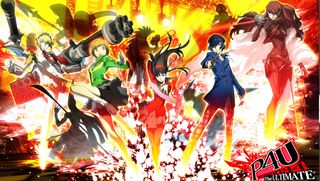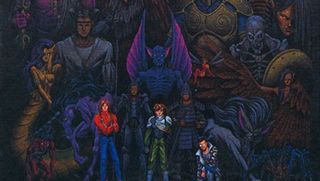Persona A beginners guide
Prepare your brain for an onslaught of niche JRPGs

The newest fighting game from the Arc Systems, the team behind Guilty Gear and Blaz Blue, is out this week and for most fighting game fans, that's all they need to know. But the game in question, Persona 4: Arena, has a ton of history attached, reaching back as far as the late 1980s and the NES. If you never played Persona before or any of the related Shin Megami Tensei games, or even you have, there's much to learn.
Though the series is known for its density, well take you through the history of Persona and its parent franchise Shin Megami Tensei as delicately as we can. It all started more than 20 years ago in Japan
Shin Megami Tensei begins

It all began on the Japanese version of the NES, the Famicom, with the original Megami Tensei, which in turn was based on a popular novel of the same name. The role-playing game had you playing as a Japanese teen who accidentally releases demons into the world using a computer program. Despite the differences between the diverse collection of SMT sub-series, this intersection of technology and ageless demons is almost always present.
From the start the series stood out from JRPG competition like Final Fantasy, not only because of its modern setting, but also its more PC inspired first-person view. And it was way ahead of the curve with its monster-collecting gameplay. By the time the series adopted its current name of Shin Megami Tensei on the Super Famicom (Japan's Super NES), it had established a healthy cult following in Japan, but publisher Atlus had yet to introduce the series to the West, probably due in some small part to Nintendo's restrictions on demonic imagery. This would eventually change.
Jack Frost and his friends come to America

After dipping its toe in the US market, the first SMT game for North America is a real anomally. Starring two of the cuter SMT monsters, Jack Frost and Pyro Jack, Jack Bros was a more casual adventure that would have been more inviting were it not for the fact that it was on Virtual Boy. The very red 3D portable system was troubled from the start and cancelled quickly, but at least Jack Bros has the dubious distinction of being one of the best VB titles ever.
After Jack Bros, Atlus struggled for several years to find a way to get the series to catch on outside of Japan. Another attempt included their own approach to Pokemon (fitting since SMT blazed the trail in monster collection) in a game that featured Jack Frost and much of the rest of SMTs unique collection of monsters. Called Devil Children in Japan and softened to DemiKids for the US, it still never really caught on, but gradually the series was making a name for itself with perceptive western RPG players.
The first two Personas

Over the next ten years SMT grew in strange ways, introducing spin-offs that covered the fantasy genre as well as Pokemon-influenced games aimed at kids and those set in a Matrix-style digital future. More titles were coming to the US on the PlayStation and PS2, including the third game in the main series, Nocturne. Atlus even gave a chance to the High School set spin-off Persona, though it got off to a rocky start.
Sign up to the 12DOVE Newsletter
Weekly digests, tales from the communities you love, and more
The first Persona was localized to remove many of the references to Japanese culture, renaming most of the characters and arcana. This might have made the series more digestible to Americans, but it removed much of the series character, and future releases chose to maintained much of its distinct cultural style. Persona 2 was skipped over initially for US release, perhaps because its plot was even more mature and Japanese than the last games, though both titles eventually got proper localizations when they were recently rereleased on the PSP.
What are Personas?

The Persona series particular approach to Arcana and other occult arts is through Personas, magical versions of someones true self. Whenever these high school students encounter monsters, they battle using these empowered beings that level-up alongside them. Different games in the series call on Personas in different ways, most striking being the third games use of shooting yourself in the head with an Evoker.
Persona 3

Persona 3, with its intense story and very Japanese setting, seemed like a longshot to be released in the US, but Atlus took a chance and RPG players were better off for it. Set in an high-class Tokyo high school, the silent protagonist starts his school year joining SEES, a club that teaches him to enter the monster-filled Dark Hour and summon his Persona to battle the Greater Shadows in hopes of averting catastrophe. Of course all that dungeon exploring has to be balanced with making new friends as the clock keeps on ticking down on the time left in the school year.
Only so much can be done in each day and the year keeps crawling forward, making Persona 3 a compelling combination of RPG adventure, dating sims and time management. It was the story that really earned P3 its accolades, a maturely written tale of sacrifice and redemption that took all the characters through dramatic changes. Many called it the best RPG of the year, if not of all time on the PS2.
Meet the cast

The lead character in P3 is purposefully vague, letting the player define their character through their actions, but his friends are clearly defined. Theres the lively Yukari, the approachable Junpei, the tough Akihiko, and the mature-for-her-age Mitsuru rounding out the SEES team of Shadow hunters, but the biggest fan favorite is likely Aegis. An amnesiac robot that joins the team and learns to be human by experiencing school with them, Aegis was so big she ended up starring in the P3s epilogue The Answer.
Making new friends for XP

If making friends in real life worked like it did in Persona, wed be less antisocial. As introduced by Igor and his remarkably long nose in Persona 3, making bonds with other people opens up new possibilities for your characters and their Personas. Become close enough with the characters, and that includes dating team members of the opposite sex, and youll get bonuses and powers that wont unlock by simple dungeon-grinding. In both 3 and 4, you need to make the most of your high school years, as they may be the best (and last) years of your life.
P3P vs FES

So now youre sold on Persona 3, but whats the best way to play it? The fans are divided on that. The directors cut version of P3 called Persona 3: FES came out a year after the original and tweaked a few things while also expanding the already huge game with a 30 hours of epilogue gameplay. Two years after that Persona 3 Portable aka P3P came to the PSP with more gameplay enhancements and the choice to play as a female protagonist. P3P updated the combat to match the battles in Persona 4, adding in new plots and character cameos, but the anime cutscenes and other extras of the console version had to be cut to fit the game on a UMD.
In our opinion, go with FES, based both its cheap availability on PlayStation Network and the more fully featured presentation, though the appeal of playing P3 on a portable whether the PSP or Vita might be the deciding factor for some of you.
Persona 4

After the darkness of P3, Atlus decided to lighten things up just a little with Persona 4. The high school setting is moved from Tokyo to the more relaxed, rural atmosphere of Inaba, though darkness is starting to creep in along with unnatural and unpredictable fog. The typically silent protagonist is a new transfer student who arrives during the start of a mysterious string of murders that have something to do with his TVs ability to tune into the Midnight Channel, a show that will pull you in if you arent careful.
The hero teams up with his new school chums to explore the Midnight Channel to search for answers to whats corrupting the small town. Persona 4 improved the few flaws that were in P3, deepening the combat and making the social aspects an even bigger deal. The plot also went even more personal with the characters, causing players to form even deeper bonds with the cast.
Henry Gilbert is a former 12DOVE Editor, having spent seven years at the site helping to navigate our readers through the PS3 and Xbox 360 generation. Henry is now following another passion of his besides video games, working as the producer and podcast cohost of the popular Talking Simpsons and What a Cartoon podcasts.

Pokemon Platinum's most obscure feature was a reward seemingly given to just 20 players lucky enough to participate in a complicated limited-time event with a lottery prize

37-year-old studio behind iconic PC game Myst and one of the longest-surviving indies in the world just laid off "roughly half the team"











